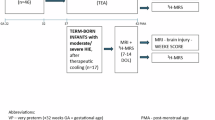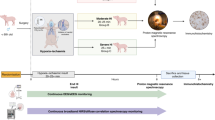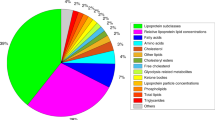Abstract
Studies of the brains of severely birth-asphyxiated infants using proton(1H) magnetic resonance spectroscopy (MRS) have shown changes indicating a rise in cerebral lactate (Lac) and a fall in N- acetylaspartate (Naa). The aim of this study was to test two hypotheses: 1) that these changes can be reproduced in the newborn piglet after transient reversed cerebral hypoxia-ischemia, and their time course determined; and 2) that changes in Lac peak-area ratios are related to changes in phosphorylation potential as determined by phosphorus(31P) MRS. Eighteen piglets aged <24 h were anesthetized and ventilated. Twelve underwent temporary occlusion of the carotid arteries and hypoxemia, and six served as sham-operated controls. 1H and 31P spectra were acquired alternately, both during the insult and for the next 48 h, using a 7-tesla spectrometer. During hypoxia-ischemia, the median Lac/total creatine (Cr) peak-area ratio rose from a baseline of 0.14 (interquartile range 0.07-0.27), to a maximum of 4.34 (3.33-7.45). After resuscitation, Lac/Cr fell to 0.75 (0.45-1.64) by 2 h, and then increased again to 2.43(1.13-3.08) by 48 h. At all stages after resuscitation Lac/Cr remained significantly above baseline and control values. Naa/Cr was significantly reduced below baseline and control values by 48 h after resuscitation. The increases in the Lac peak-area ratios were concomitant with the falls in the[phosphocreatine (PCr)*]/[inorganic phosphate (Pi)] ratio, during both acute hypoxia-ischemia and delayed energy failure. The maximum Lac/Naa during delayed energy failure correlated strongly with the minimum[nucleotide triphosphate (NTP)]/[exchangeable phosphate pool (EPP)](r = -0.94, p < 0.0001). We conclude that both hypotheses have been confirmed.
Similar content being viewed by others
Log in or create a free account to read this content
Gain free access to this article, as well as selected content from this journal and more on nature.com
or
Abbreviations
- Cho:
-
choline-containing compounds
- Cr:
-
creatine plus phosphocreatine
- EPP:
-
exchangeable phosphate pool
- FID:
-
free induction decay
- 1H:
-
proton
- Lac:
-
lactate
- MABP:
-
mean arterial blood pressure
- MRS:
-
magnetic resonance spectroscopy
- Naa:
-
N- acetylaspartate
- NTP:
-
nucleotide triphosphate
- PCr:
-
phosphocreatine
- pHi:
-
intracellular pH
- Pi:
-
inorganic phosphate
- ppm:
-
parts per million
- PRESS:
-
point-resolved spectroscopy
- T 2 :
-
transverse relaxation time
- TR:
-
repetition time
References
Azzopardi D, Wyatt JS, Cady EB, Delpy DT, Baudin J, Stewart AL, Hope PL, Hamilton PA, Reynolds EOR 1989 Prognosis of newborn infants with hypoxic-ischemic brain injury assessed by phosphorus magnetic resonance spectroscopy. Pediatr Res 25: 445–451.
Roth SC, Edwards AD, Cady EB, Delpy DT, Wyatt JS, Azzopardi D, Baudin J, Townsend J, Stewart AL, Reynolds EOR 1992 Relation between cerebral oxidative metabolism following birth asphyxia and neurodevelopmental outcome and brain growth at one year. Dev Med Child Neurol 34: 285–295.
Roth S, Baudin J, Cady E, Townsend J, Wyatt J, Reynolds O, Stewart A 1995 Deranged cerebral oxidative phosphorylation following birth asphyxia and neurodevelopmental outcome at four years. Pediatr Res 38: 452
Lorek A, Takei Y, Cady EB, Wyatt JS, Penrice J, Edwards AD, Peebles D, Wylezinska M, Owen-Reece H, Kirkbride V, Cooper CE, Aldridge RF, Roth S, Brown G, Delpy DT, Reynolds EOR 1994 Delayed(“secondary”) cerebral energy failure after acute hypoxia-ischemia in the newborn piglet: continuous 48-hour studies by phosphorus magnetic resonance spectroscopy. Pediatr Res 36: 699–706.
Blumberg RM, Cady EB, Wigglesworth JS, McKenzie JE, Edwards AD 1997 Relation between delayed impairment of cerebral energy metabolism and infarction following transient focal hypoxia-ischaemia in the developing brain. Exp Brain Res 113: 130–137.
Buchli R, Rumpel H, Maeder U, Nedelcu H, Martin E 1995 Hypoxic ischemic brain damage in neonatal rats monitored by 31P magnetic resonance spectroscopy. Pediatr Res 38: 428
Lolley RN, Balfour WM, Samson FE 1961 The high energy phosphates in developing brain. J Neurochem 7: 289–297.
Urenjak J, Williams SR, Gadian DG, Noble M 1993 Proton nuclear magnetic resonance spectroscopy unambiguously identifies different neural cell types. J Neurosci 13: 981–989.
Miller BL 1991 A review of chemical issues in 1H NMR spectroscopy: N-acetyl-L-aspartate, creatine and choline. NMR Biomed 4: 47–52.
Groenendaal F, Veenhoven RH, Van Der Grond J, Jansen GH, Witkamp TD, De Vries LS 1994 Cerebral lactate and N- acetylaspartate/choline ratios in asphyxiated full-term neonates demonstrated in vivo using proton magnetic resonance spectroscopy. Pediatr Res 35: 148–151.
Hanrahan JD, Sargentoni J, Azzopardi D, Manji K, Cowan FM, Rutherford MA, Cox IJ, Bell JD, Bryant DJ, Edwards AD 1996 Cerebral metabolism within 18 hours of birth asphyxia: a proton magnetic resonance spectroscopy study. Pediatr Res 39: 584–590.
Penrice J, Cady EB, Lorek A, Wylezinska M, Amess PN, Aldridge RF, Stewart A, Wyatt JS, Reynolds EOR 1996 Proton magnetic resonance spectroscopy of the brain in normal preterm and term infants, and early changes after perinatal hypoxia-ischemia. Pediatr Res 40: 6–14.
Peden CJ, Rutherford MA, Sargentoni J, Cox IJ, Bryant DJ, Dubowitz LMS 1993 Proton spectroscopy of the brain following hypoxic-ischaemic injury. Dev Med Child Neurol 35: 502–510.
Hore PJ 1983 Solvent suppression in Fourier transform nuclear magnetic resonance spectroscopy. J Magn Reson 55: 283–300.
Bodenhausen G, Freeman R, Turner DL 1977 Suppression of artifacts in two-dimensional J spectroscopy. J Magn Reson 27: 511–514.
Akitt JW 1978 A new type of function for resolution enhancement. J Magn Reson 32: 311–324.
Cerdan S, Parilla R, Santoro J, Rico M 1985 1H NMR detection of cerebral myo-inositol. FEBS Lett 187: 167–172.
Arus C, Chong Y, Barany M 1985 Proton nuclear magnetic resonance spectra of excised rat brain. Assignment of resonances. Physiol Chem Phys Med NMR 17: 23–33.
Cady EB 1991 A reappraisal of the absolute concentrations of phosphorylated metabolites in the human neonatal cerebral cortex obtained by fitting Lorentzian curves to the 31P NMR spectrum. J Magn Reson 91: 637–643.
Morris GA, Freeman R 1978 Selective excitation in Fourier transform nuclear magnetic resonance. J Magn Reson Imaging 29: 433–462.
Petroff OAC, Prichard JW 1985 Cerebral intracellular pH by 31P nuclear magnetic resonance spectroscopy. Neurology 35: 781–788.
Haaland K, Steen PA, Thoresen M 1996 Cerebral tympanic and colonic thermometry in the piglet. Reprod Fertil Dev 8: 125–128.
Vicario C, Medina JM 1992 Metabolism of lactate in the rat brain during the early neonatal period. J Neurochem 59: 32–40.
Pirttilä T-RM, Kauppinen RA 1992 Recovery of intracellular pH in cortical brain slices following anoxia studied by nuclear magnetic resonance spectroscopy: role of lactate removal, extracellular sodium and sodium/hydrogen exchange. Neuroscience 47: 155–164.
Amess P, Cady EB, Penrice J, Wylezinska M, Stewart A, Wyatt JS, Reynolds EOR 1996 Cerebral proton metabolite concentrations in term infants following perinatal hypoxia-ischaemia and neurodevelopmental outcome at one year. Proceedings of the British Paediatric Association Annual Meeting 68: 25
Walz W, Mukerji S 1990 Simulation of aspects of ischemia in cell culture: changes in lactate compartmentation. Glia 3: 522–528.
Mun-Bryce S, Kroh FO, White J, Rosenberg GA 1993 Brain lactate and pH dissociation in edema: 1H and 31P-NMR in collagenase-induced haemorrhage in rats. Am J Physiol 265:R697–R702.
Hugg JW, Duijn JH, Matson GB, Maudsley AA, Tsuruda JS, Gelinas DF, Weiner MW 1992 Elevated lactate and alkalosis in chronic human brain infarction observed by 1H and 31P MR spectroscopic imaging. J Cereb Blood Flow Metab 12: 734–744.
Pryds O, Greisen G, Lou H, Friis-Hansen B 1990 Vasoparalysis associated with brain damage in asphyxiated term infants. J Pediatr 117: 119–125.
Wyatt JS 1993 Near infrared spectroscopy in asphyxial brain injury. Clin Perinatol 20: 369–378.
Brown GC, Bolanos JP, Heales SJR, Clark JB 1995 Nitric oxide produced by activated astrocytes rapidly and reversibly inhibits cellular respiration. Neurosci Lett 193: 201–204.
Brown GC, Cooper CE 1994 Nanomolar concentrations of nitric oxide reversibly inhibit synaptosomal cytochrome oxidase respiration by competing with oxygen at cytochrome oxidase. FEBS Lett 365: 295–298.
Schapira AHV, Cooper JM 1994 Inborn and induced defects of the mitochondrial respiratory chain. Biochem Soc Trans 22: 996–1001.
López-Villegas D, Lenkinski RE, Wehrli SL, Wen-Zhe H, Douglas SD 1995 Lactate production by human monocytes/macrophages determined by proton MR spectroscopy. Magn Reson Med 34: 32–38.
Mehmet H, Yue X, Squier MV, Lorek A, Cady EB, Penrice J, Sarraf C, Wylezinska M, Kirkbride V, Cooper C, Brown GC, Wyatt JS, Reynolds EOR, Edwards AD 1994 Increased apoptosis in the cingulate sulcus of newborn piglets following transient hypoxia-ischaemia is related to the degree of high energy phosphate depletion during the insult. Neurosci Lett 181: 121–125.
Provencher SW 1993 Estimation of metabolite concentrations from localised in vivo proton NMR spectra. Magn Reson Med 30: 672–679.
Cady EB, Lorek A, Penrice J, Wylezinska M, Cooper CE, Brown GC, Owen-Reece H, Kirkbride V, Wyatt JS, Reynolds EOR 1994 Brain-metabolite transverse relaxation times in magnetic resonance spectroscopy increase as adenosine triphosphate depletes during secondary energy failure following acute hypoxia-ischaemia in the newborn piglet. Neurosci Lett 182: 201–204.
Acknowledgements
The authors thank Richard Aldridge for his invaluable technical assistance.
Author information
Authors and Affiliations
Additional information
Supported by the Medical Research Council, UK, and the Wellcome Trust.
Rights and permissions
About this article
Cite this article
Penrice, J., Lorek, A., Cady, E. et al. Proton Magnetic Resonance Spectroscopy of the Brain during Acute Hypoxia-Ischemia and Delayed Cerebral Energy Failure in the Newborn Piglet. Pediatr Res 41, 795–802 (1997). https://doi.org/10.1203/00006450-199706000-00001
Received:
Accepted:
Issue date:
DOI: https://doi.org/10.1203/00006450-199706000-00001
This article is cited by
-
Systemic pro-inflammatory cytokine status following therapeutic hypothermia in a piglet hypoxia-ischemia model
Journal of Neuroinflammation (2017)
-
Patterns of neonatal hypoxic–ischaemic brain injury
Neuroradiology (2010)
-
Proton Magnetic Resonance Spectroscopy Improves Outcome Prediction in Perinatal CNS Insults
Journal of Perinatology (2003)



